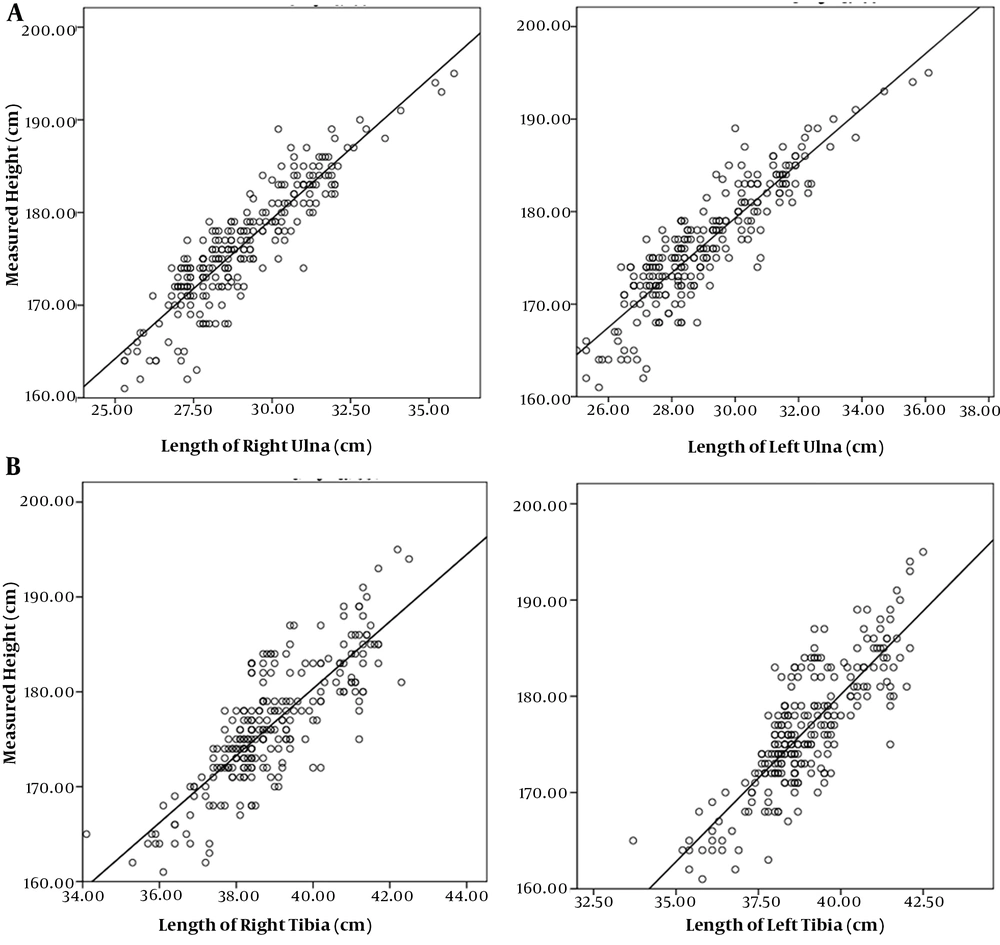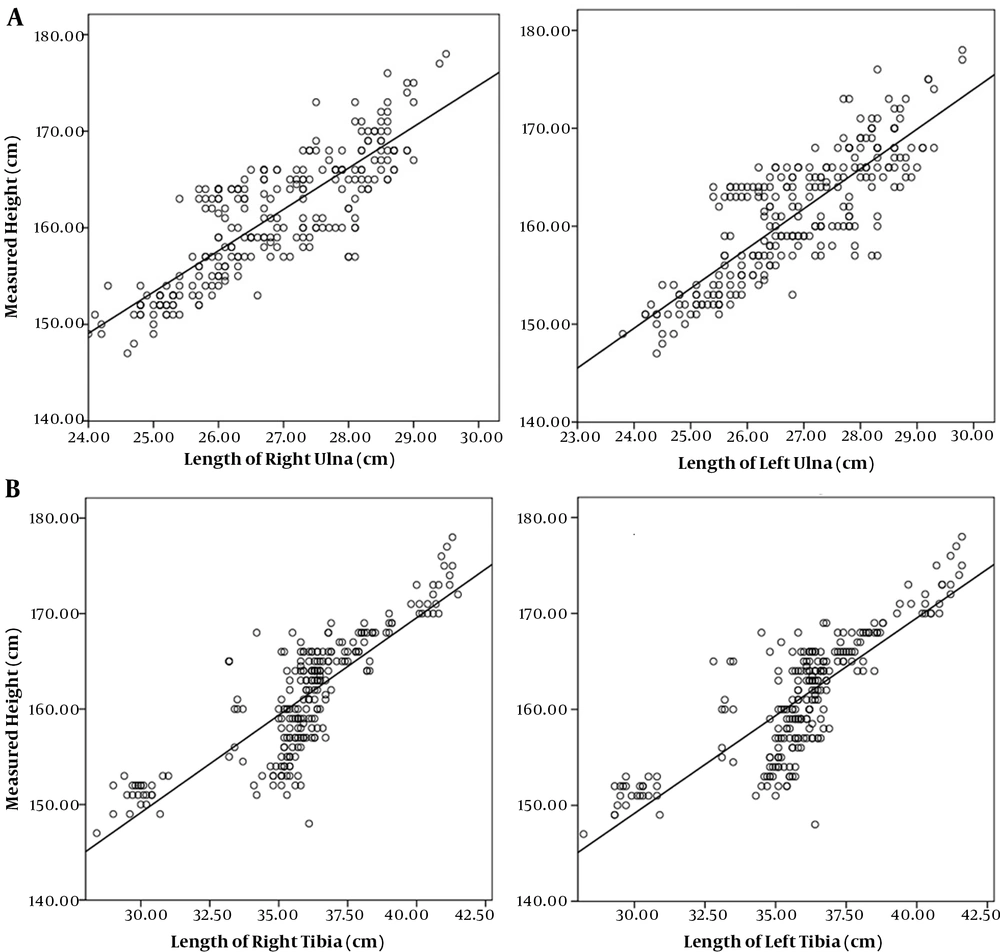1. Background
Stature as a physical characteristic is one of the principal parameters of identification and assessment (1, 2). Height is a fundamental health indicator especially used to assess the medicinal requirements of hospitalized patients. However, in some cases, including people with particular disorders, people of age, and hospitalized patients, the concept of height becomes an intricate challenge for having a direct and accurate assessment (3, 4). The relationship between height and different body parts such as the head, trunk, and upper and lower limbs has always been an interesting subject for anatomists and anthropologists; moreover, it can also be very useful for forensic medicine experts, especially in providing them with a statistical database for anthropometrical measurements in future studies (2, 5-7). For this purpose, various screening tools have been introduced and applied, complementing other variables, including medical, clinical, biochemical, anthropometric, and dietary measurements (8). Regardless of the availability of these tools, the accuracy of height measurement when acquired with certain difficulties becomes inherently questionable (9, 10). Hence, it is essential to devise alternative methods to measure stature accurately and easily. In this manner, several studies have explored a variety of methods such as using arm span, knee height, and ulna length to find a reliable formula that gives an approximate estimate for stature when the actual height is difficult to be measured (11-15). Furthermore, height as a central anthropometric measure can be influenced by various factors, such as genetics, ethnicity, and other environmental circumstances (16, 17). In this respect, it is necessary to find an applicable and suitable equation to screen patients from each nation or ethnic group or to identify the absence of this equation among people of different parts of each region like the northern population of Iran. Since ulna and tibia lengths can be easily measured, and considering the availability and inexpensiveness of related tools, the method appears as a suitable alternative for height estimation.
2. Objectives
This study aimed to offer a proper formula for the prediction of height based on the lengths of the ulna and tibia of adults in north of Iran.
3. Methods
3.1. Study Population
This study was approved by the Medical Research Ethics Committee of Babol University of Medical Sciences (No: 9441667). The subjects were selected from a pool of 20 to 40-year-old staff, students, and patients at Babol Health center. People who were left-handed and those with any kinds of bone surgery, fractures, physical disabilities, and skeletal malformations that could potentially influence height or ulna and tibia measurements were excluded. Overall, 528 subjects were selected using the simple random sampling method from the admission list. Twenty-eight subjects were excluded based on the exclusion criteria. The final sample of 500 subjects was divided into two groups based on gender (250 males versus 250 females). In line with the code of conduct, the study was explained to all the participants, and afterwards, consent forms were signed by them prior to the start of the study.
3.2. Anthropometric Measurements
All assessments were performed between 9.00 a.m. and 4 p.m. with the same equipment and trained technicians to minimize methodological errors and potential biases. Height was measured by a portable stadiometer (Iran Teb, Tehran) that was mounted on the wall. Height was measured for each participant to the nearest 0.1 cm while standing in erect position, facing forward, with Frankfort horizontal head position and bare feet without a hat or a hairstyle that could affect the process of measurement (18). The forearm (ulna) was measured using an anthropometric tape (Sewing meter, China) from the point of olecranon extending to the point of the wrist (styloid). For each participant, the left and right forearms were measured while flexed across the chest and in front of the body without any objects like a wristband, a bracelet, or a watch (13). The measurements were repeated three times and were eventually recorded to the nearest 0.1 cm. Left and right tibia lengths were measured by a sewing meter and were recorded to the nearest 0.1 cm. It was considered as the distance between the upper border of the medial condyle and the tip of the left medial malleolus, while the knee was kept at a 90-degree angle in a sitting position.
3.3. Statistical Analysis
Data analysis was performed using SPSS version 18. The mean measurement was reported as mean plus standard deviation. Pearson’s correlation coefficient and simple linear regression were run to examine the relationship between ulna and tibia lengths and height and stature in both genders. A P-value of less than 0.05 was considered significant.
4. Results
The mean (SD) heights of the male and female participants were 176.45 (11.9) cm and 161.29 (10.11) cm, respectively. In men, the mean (SD) lengths of the right and left ulna were 29.05 (1.63) cm and 29.03 (1.44) cm, respectively, and they were 27.74 (1.49) cm and 27.78 (1.45) cm in women, respectively. Moreover, the mean lengths of the right and left tibia were respectively 38.86 (1.33) cm and 38.88 (1.25) cm in men and 35.89 (1.01) and 35.88 (1.09) in women.
Table 1 shows the relationship between the actual height and ulna and tibia lengths. There was a significant difference between the mean of ulna and tibia in confidence level of adjusted R square for select the equation. Height formula was suggested for right ulna length in both genders as it shows the highest level of adjusted R square with an impressive significance level (P < 0.01). Moreover, ulna and tibia in men and women were significantly different level (Table 1).
| Group | Correlation Between Height with Ulna and Tibia | Regression Coefficients | Predicted Height (cm) | Equation | |||
|---|---|---|---|---|---|---|---|
| Adj. r2 | P-Value | A Slope Constant | B | 95%CI | Mean (SD) | ||
| Male | |||||||
| Right ulna | 0.805 | < 0.001 | 3.02 | 88.71 | 2.83 - 3.20 | 176.0 (4.3) | Predicted height [cm] = 88.70 + (3.02 × ulna length [cm]) |
| Left ulna | 0.792 | < 0.001 | 2.96 | 90.58 | 2.76 - 3.14 | 175.6 (5.8) | Predicted height [cm] = 90.57 + (2.95 × ulna length [cm]) |
| Right tibia | 0.568 | < 0.001 | 3.54 | 38.93 | 3.25 - 3.80 | 179.1 (5.4) | Predicted height [cm] = 38.93 + (3.53 × ulna length [cm]) |
| Left tibia | 0.561 | < 0.001 | 3.47 | 41.22 | 3.27 - 3.61 | 180.7 (4.8) | Predicted height [cm] = 41.22 + (3.74 × ulna length [cm]) |
| Female | |||||||
| Right ulna | 0.693 | < 0.001 | 4.28 | 46.41 | 4.04 - 4.41 | 166.3 (1.9) | Predicted height [cm] = 46.41 + (4.27 × ulna length [cm]) |
| Left ulna | 0.671 | < 0.001 | 4.07 | 51.98 | 3.88 - 4.43 | 164.1 (3.2) | Predicted height [cm] = 51.98 + (4.06 × ulna length [cm]) |
| Right tibia | 0.667 | < 0.001 | 2.04 | 87.91 | 1.76 - 2.34 | 168.4 (4.0) | Predicted height [cm] = 87.91 + (2.04 × ulna length [cm]) |
| Left tibia | 0.667 | < 0.001 | 2.04 | 88.05 | 1.82 - 2.36 | 161.0 (3.80) | Predicted height [cm] = 88.05 + (2.03 × ulna length [cm]) |
Correlation Between the Measured Height and Suggested Equations for Predicted Height Based on Ulna and Tibia Lengths by Gender
The correlation between right ulna length and height was moderately strong and significant (r = 0.833 for women and r = 0.897 for men in the right ulna). Therefore, the height estimation formulae for men and women were considered as follows:
Predicted height [cm] = 88.71 + (3.02 × ulna length [cm]) and Predicted height [cm] = 46.41 + (4.28 × ulna length [cm]), respectively.
Although there was a significant relationship between the length of the tibia and height, the relationship was somewhat weak in both genders (r2 = 0.66 & r2 = 0.56 in women and men, respectively, P < 0.001). Other equations were also reliable, as presented in Table 1.
Figures 1 and 2 display the scatter diagram related to ulna and tibia lengths from both left and right sides against height for each gender. The solid line represents the least-squares best-fit regression and height estimation based on the related regression equation. The majority of the values for the right ulna subgroups in both groups were above the predicted regression. The overall trend of the right ulna agreed more with the equation prediction in both genders, such that these concordances were supported by the regression coefficients (Table 1).
Height prediction using the four variables (right and left ulna and tibia lengths) by multivariate regression analysis showed (adj. r2 = 0.804 and r2 = 0.831 in women and men, respectively) the almost similar correlation coefficients for the stature estimation based on right ulna length.
5. Discussion
This study was carried out to examine the appropriate equations for stature estimation and prediction using ulna and tibia lengths in healthy Iranian adults. The results showed that the correlation coefficients between height and ulna length were higher than those the tibia length in both genders. Moreover, between right and left ulna lengths, right ulna length with a greater correlation coefficient proved to be more accurate for height prediction in men and women in the north of Iran. In this regard, some other studies were performed to investigate reliable stature formulae according to long bone length. It had been understood that stature equations differ based on various factors such as gender, ethnic group, and study methods (19-22). Madden et al. claimed that their formula for assessing the height based on the length of ulna correlated closely with the actual height in white participants, while it had failed to provide an accurate assessment of the actual height in black and Asian participants (4). Moreover, according to other studies, it has been revealed that the stature formulae of people can vary, especially considering those who live in different parts of the same state (20, 23). In this study, the participants were of similar ethnicity and were residing in the same region. Moreover, there is also the theory that a person’s lifestyle, namely urban or rural life, childhood nutrition and growth, and type of job, can affect stature. According to the available evidence, several environmental factors, such as vigorous physical activity, infectious diseases, hormonal disorders, malnutrition, and poor living conditions, can prevent the individual from reaching the genetically determined adult height, especially caused by a decrease in the growth of legs (24). Hence, stature estimation and prediction based on the upper limbs may not be reliable among those populations. Therefore, all conditions should be considered to provide the appropriate formula to estimate height.
Since easy and fast equations for the calculation of stature are key in malnutrition screening, examining a bedridden patient, and forensic identifications, multiple-variable equations by multivariate regression analysis were not performed. In this study, left-handed subjects were not included due to the availability of right-handed people, and the unavailability of an acceptable left-handed sample size within the time of research. Although there was not a difference between the lengths of the right and the left ulna, there is a concern about the use of these equations, especially considering different lengths of ulna between the dominant and the non-dominant hands in left-handed people, which affects equations and the accuracy of prediction. In this regard, our results may not be useful for left-handed individuals considering the dominant hand as a significant factor in the measurement of ulna lengh. We, therefore, highly recommend another study to be carried out among left-handed people.
5.1. Conclusions
It could be concluded that the equations for predicting height based on ulna length, especially the right ulna in adults, provides a reliable estimation of height in healthy adults located in the north of Iran.

